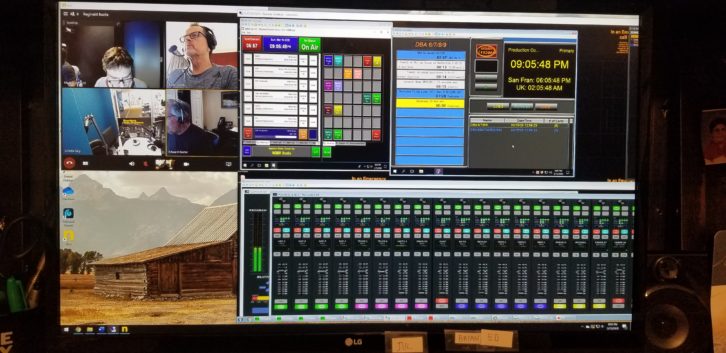As part of our research for Radio World’s new ebook about remote broadcasting, we contacted Charlie Vollmer, technical operations team leader at Bloomberg Radio, to ask about how the organization responded to the pandemic. Below we share that interview in full. You can read the ebook here.

Radio World: How is your broadcasting workflow today different that it was before coronavirus?
Charlie Vollmer: Bloomberg News has over 2,700 journalists and analysts located in more than 120 countries around the world. Although our technical operations come from our world headquarters in New York, we are well-versed in working with many of those remote locations daily.
Before the pandemic hit, most of our staff would report to their local newsroom on a daily basis. By mid-March, almost all of our on-air staff was working from home globally. We’ve traded in-person collaboration for video conferences and phone calls. We’ve all had to heavily rely on instant messaging during live programming as opposed to talking to each other in real time through the other side of the glass.
We normally create over 27 hours of unique radio content across all of our platforms each weekday. Throughout the pandemic we haven’t missed a single hour. This is all a credit to the infrastructure investments Bloomberg has made over the years, paired with some incredibly intelligent, dedicated, and hard-working staff across all aspects of operation.
RW: What technologies or products are being used to enable your new workflows, for the major portions of your on-air product?
Vollmer: Most of our anchors were given Comrex NX codecs with sportscaster style boom mics to install in their homes. For reporters and our affiliate team, we heavily relied on the various LUCI Live apps.
As far as actually running the shows, our technical producers were given high-performance laptops so they could VPN into designated PCs back in our headquarters. From there, they were given full access to our Wheatstone LXE remote mixing app, automation and audio playback systems. We have various audio hybrids set up with a program feed from each station’s air chain so they can listen in real time to the broadcast they’re running.
RW: What was the biggest technical management challenge you had to meet, in the first days or weeks of the coronavirus?
Vollmer: We have robust systems that I knew we would be successful with. The first step was to design and implement a process to actually run the radio station from home. We pared it down so an op could successfully operate the board using only a laptop connection to the office.
The next step was sending out equipment to each member of our on-air staff. That led to plenty of unforeseen challenges as we had to walk each and every person through setting up our kits in their unique and personal environment.
In the end, we probably created 60+ custom broadcast spaces that our staff still use today. A one-size-fits-all approach doesn’t always work in the broadcast industry. We needed to act quickly to get this done and adjust on the fly to execute the plan.
RW: Was there a particular solution, feature or application that you think your peers would be interested to hear about?
Vollmer: I think the biggest tool is being able to control all these systems remotely. You no longer need physical equipment in front of you to operate successfully. We should all be comfortable working in the cloud and using virtual systems.
RW: How will radio broadcast operations for our industry be permanently changed in the long term as a result of this health crisis?
Vollmer: In my personal opinion, I think we’re going to see a lot of changes to the way many industries operate in the physical workplace. Stations will need to have a diversified plan for deployment of people, equipment and offices. I think every employee needs to learn to work self-sufficiently. It’s important to keep your technical skills fresh and continually learn new systems and processes.

RW: Anything else we should know?
Vollmer: I have one great story that illustrates how the radio community comes together during a crisis. I knew on a Sunday night that we had to figure out a way to get some of our staff in our Boston office broadcasting from home by 3 p.m. Monday afternoon. At 9 a.m., Monday morning I called Comrex and explained the situation to one of their sales and marketing representatives. She immediately set aside three NX codecs for our anchors. Going the extra mile, the techs were nice enough to program all of our IPs into the codecs. One anchor made a 45-minute trip up to Devens, Mass., to pick up the codecs. I simultaneously sent site-to-store orders to a local Guitar Center and Home Depot for mics, headsets and Cat-6. A second anchor grabbed those items and then met the rest of the crew in Natick, Mass., to swap all the needed gear. We had them all set up at home by noon for that 3 p.m. show and they have all been working from home since.







